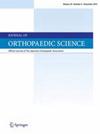Joint-preserving effect and patient-reported outcomes of transtrochanteric curved varus osteotomy for osteonecrosis of the femoral head
IF 1.5
4区 医学
Q3 ORTHOPEDICS
引用次数: 0
Abstract
Background
This study assessed the hip survival rate and patient-reported outcome measures (PROMs) of transtrochanteric curved varus osteotomy (CVO) for osteonecrosis of the femoral head (ONFH) compared with those of conservative management.
Methods
The CVO group comprised 32 consecutive patients (39 hips) who underwent CVO for ONFH between 2000 and 2011. The conservative group consisted of 36 consecutive patients (37 hips) who were managed conservatively for at least 1 year after collapse and who had ONFH classified by the Japanese Investigation Committee of Health and Welfare as type B or C1, for which CVO is indicated. Kaplan–Meier analysis of hip survival used any ONFH-related therapeutic surgery as the endpoint. PROMs were evaluated for all patients with surviving hips and radiographs available at the latest follow-up.
Result
The 10-year hip survival rate in the CVO group was 86.7%, which was significantly higher than the 51.0% 5-year survival rate in the conservative group (p < 0.0001). The Oxford Hip Score and UCLA Activity Score were significantly better in the CVO group without joint space narrowing than in the conservative group, with no significant differences between the CVO group with joint space narrowing and the conservative group.
Conclusion
CVO could preserve hip joints more effectively than conservative follow-up after collapse, although the presence of joint space narrowing could reduce satisfaction levels even in patients with long-term hip survival.
经转子弯屈截骨术治疗股骨头坏死的关节保护效果和患者报告结果。
本研究评估了经股骨粗隆弯曲内翻截骨术(CVO)治疗股骨头坏死(ONFH)与保守治疗的髋关节存活率和患者报告的预后指标(PROMs)。方法CVO组包括2000年至2011年间连续32例(39髋)因ONFH接受CVO治疗的患者。保守组包括36例连续患者(37髋),这些患者在崩溃后至少保守治疗1年,并且ONFH被日本卫生福利调查委员会分类为B型或C1型,其中CVO是指。Kaplan-Meier分析以任何与onfh相关的治疗性手术作为终点。在最近的随访中,对所有存活髋关节和x线片的患者进行PROMs评估。结果CVO组髋关节10年生存率为86.7%,显著高于保守组51.0%的5年生存率(p <;0.0001)。无关节间隙变窄的CVO组Oxford髋关节评分和UCLA活动评分明显优于保守组,有关节间隙变窄的CVO组与保守组无显著差异。结论髋关节塌陷后,cvo比保守随访更能有效地保护髋关节,尽管关节间隙狭窄的存在会降低患者对髋关节长期生存的满意度。
本文章由计算机程序翻译,如有差异,请以英文原文为准。
求助全文
约1分钟内获得全文
求助全文
来源期刊

Journal of Orthopaedic Science
医学-整形外科
CiteScore
3.00
自引率
0.00%
发文量
290
审稿时长
90 days
期刊介绍:
The Journal of Orthopaedic Science is the official peer-reviewed journal of the Japanese Orthopaedic Association. The journal publishes the latest researches and topical debates in all fields of clinical and experimental orthopaedics, including musculoskeletal medicine, sports medicine, locomotive syndrome, trauma, paediatrics, oncology and biomaterials, as well as basic researches.
 求助内容:
求助内容: 应助结果提醒方式:
应助结果提醒方式:


